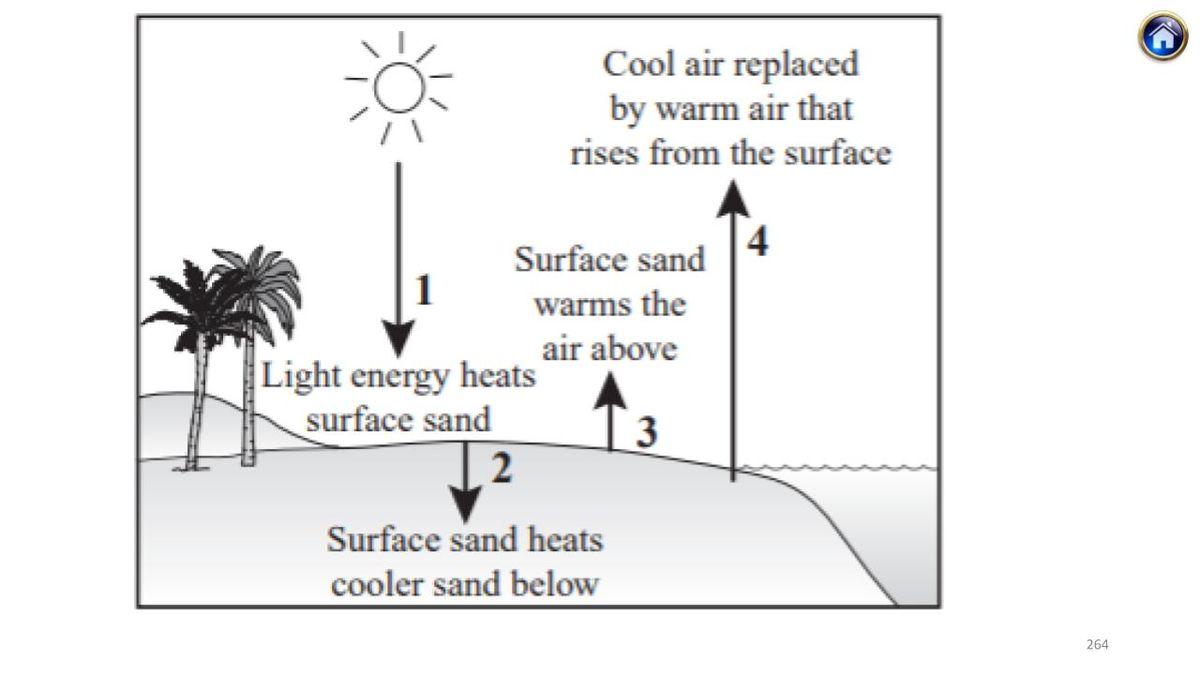
PHYSICAL SCIENCE SSA REVIEW
Quiz by Oksana Tariche
Feel free to use or edit a copy
includes Teacher and Student dashboards
Measure skillsfrom any curriculum
Measure skills
from any curriculum
Tag the questions with any skills you have. Your dashboard will track each student's mastery of each skill.
With a free account, teachers can
- edit the questions
- save a copy for later
- start a class game
- automatically assign follow-up activities based on students’ scores
- assign as homework
- share a link with colleagues
- print as a bubble sheet
35 questions
Show answers
- Q1The arrows in the picture below show several ways heat is transferred from the Sun as it strikes sand on the surface of a beach. Which arrow shows convection?3142120s
- Q2The arrows in the picture below show several ways heat is transferred from the Sun as it strikes sand on the surface of a beach. Which arrow(s) shows conduction?only 31 and 22 and 32 and 4120s
- Q3The arrows in the picture below show several ways heat is transferred from the Sun as it strikes sand on the surface of a beach. Which arrow shows radiation?4321120s
- Q4If you visit the beach on a hot summer day you will probably feel a sea breeze coming off the water onto the land. Which of the following causes this sea breeze?During the day, solar radiation warms the land more than the water.Earth is tilted toward the Sun, causing air to move inland from the water.The water is warmer than the land during the day.Hurricanes that form in the oceans blow air into the shore.120s
- Q5If you walk barefoot on hot asphalt, energy is transferred by which process?ReflectionRadiationConvectionConduction120s
- Q6When energy from the sun reaches the air above land, the air warms and rises. Along a coastline, cooler air above the ocean flows toward the land to replace this rising air. Which of the following best describe these processes?Conduction and convectionConduction, convection, and radiationRadiation and convectionRadiation and conduction120s
- Q7Vivian placed an ice cube in a tray of warm water. The following picture shows her investigation. Which statement describes the energy transfer that happens in Vivian’s investigation?Energy in the form of heat is transferred from the water to the ice cube by conductionEnergy in the form of heat is transferred from the water to the ice cube by radiation.Energy in the form of heat is transferred from the ice cube to the water by conduction.Energy in the form of heat is transferred from the ice cube to the water by radiation.120s
- Q8Kumar is studying how Earth is warmed by sunlight. The following illustration shows his model of the sun and Earth. Which process is mostly responsible for warming the soil in Kumar’s model?Radiation from the lamp reaches the soil and causes the soil to warm.Conduction between the lamp and the soil causes the soil to warm.Convection currents between the lamp and the soil cause the soil to warm.Expansion of particles in the soil causes the soil to warm.120s
- Q9Paul placed an ice cube into a beaker on a hot plate. The ice cube changed from a solid to a liquid and then to a gas. During this process, which property of the ice cube remained unchanged?MassTemperatureDensityVolume120s
- Q10When a helium balloon rises in the air, it expands. If the volume of the balloon doubles, what happens to the density of the helium inside it?The density decreases by half.The density doubles.The density stays the same.The density triples.120s
- Q11A metal coin has certain properties that can be measured. Which property of a coin is different on the moon than it is on Earth?WeightMassVolumeDensity120s
- Q12Lithium (Li), Sodium (Na), Potassium (K), Rubidium (Rb), Cesium (Cs), and Francium (Fr) are in the same column in the periodic table. Why are these elements in the same column in the periodic table?They have the same number of neutrons.They have similar chemical properties.They have atoms of the same size.They have the same number of protons.120s
- Q13How many atoms in total and what atoms combine to make up a molecule of hydrogen peroxide (H2O2)?4 atoms in total: 2 hydrogen, 2 oxygen2 atoms in total: 1 hydrogen, 1 oxygen3 atoms in total: 2 hydrogen, 1 oxygen3 atoms in total: 1 hydrogen, 2 oxygen120s
- Q14All of the following would be helpful in separating a mixture of sand and salt EXCEPTA filter paper and funnelA glass cupA magnetWater120s
- Q15Raul and Bonnie are trying to classify several objects that they found during a field trip to the beach. They collected a sample of seawater, a piece of driftwood, and several smooth pebbles. What property does the driftwood share with the pebbles that it does not share with the water?Its volume will change in different containers.Its volume does not depend on its container.Its particles move freely in all directions.Its particles vibrate, but are locked in place.120s
